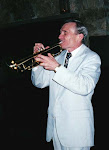 We all know and love Louis Armstrong's theme song, When it's Sleepy time Down South. The composers were two New Orleans friends, Leon and Otis Rene with actor Clarence Muse. Louis first heard the song around 1930 and, as he himself stated, "I carried it in my trunk for a year before recording it." The first recording was in April 1931 followed by a 1932 version that was part of a medley. Between Louis' big band and the All Stars, there must be thousands of live recordings of this wonderful theme that Pops performed at every show. This post will focus on two unique and equally lovely versions.
We all know and love Louis Armstrong's theme song, When it's Sleepy time Down South. The composers were two New Orleans friends, Leon and Otis Rene with actor Clarence Muse. Louis first heard the song around 1930 and, as he himself stated, "I carried it in my trunk for a year before recording it." The first recording was in April 1931 followed by a 1932 version that was part of a medley. Between Louis' big band and the All Stars, there must be thousands of live recordings of this wonderful theme that Pops performed at every show. This post will focus on two unique and equally lovely versions.The November 16, 1941 recording is by Louis' big band and is an instrumental version. The November 28, 1951 version pairs Louis' vocal and trumpet with the talented arranger Gordon Jenkins. Both versions are on the Decca label.
The big band version is quite mellow with Pops stating the melody as only he can. There are no fireworks on this rendition, just Pops playing his beloved theme from the heart. The tempo is very danceable. This must have been a favorite on Pops' dance dates. Saxes play pretty for the release. On the second chorus the band plays a brief riff to bring Louis back for the release. He does some of his patented double-timing, then settles back for some nicely placed high notes as he rides out over the band. This is not the Louis of Swing that Music, but Louis the master melodist. Even though Louis' vocal is missed, he does plenty of singing on his horn.
The Gordon Jenkins version would eventually be part of the Satchmo in Style album. Jenkins had a very distinctive way of writing for strings. He did many ballad sessions for Frank Sinatra. He was also a huge fan of Pops and loved working with him. The string work on this Sleepy Time is gorgeous. The big band version was in the key of Eflat and Louis usually played it in Dflat with the All Stars. The Jenkins arrangement is in C. The different key gives Louis' voice a deeper quality, and his trumpet bridge puts him in the unusual key of E. Despite the strange key, Pops plays a lovely bridge and takes the second eight bars up an octave. His closing vocal lines are very touching as the strings play a cascading figure around his final notes. Pops concludes with an appropriate...Yes, lord!
The 1941 version is on the Classics Cd series and Satchmo in Style is on a Verve CD (with extra material).
Until our next Louis post--
Good evening everybody!

No comments:
Post a Comment